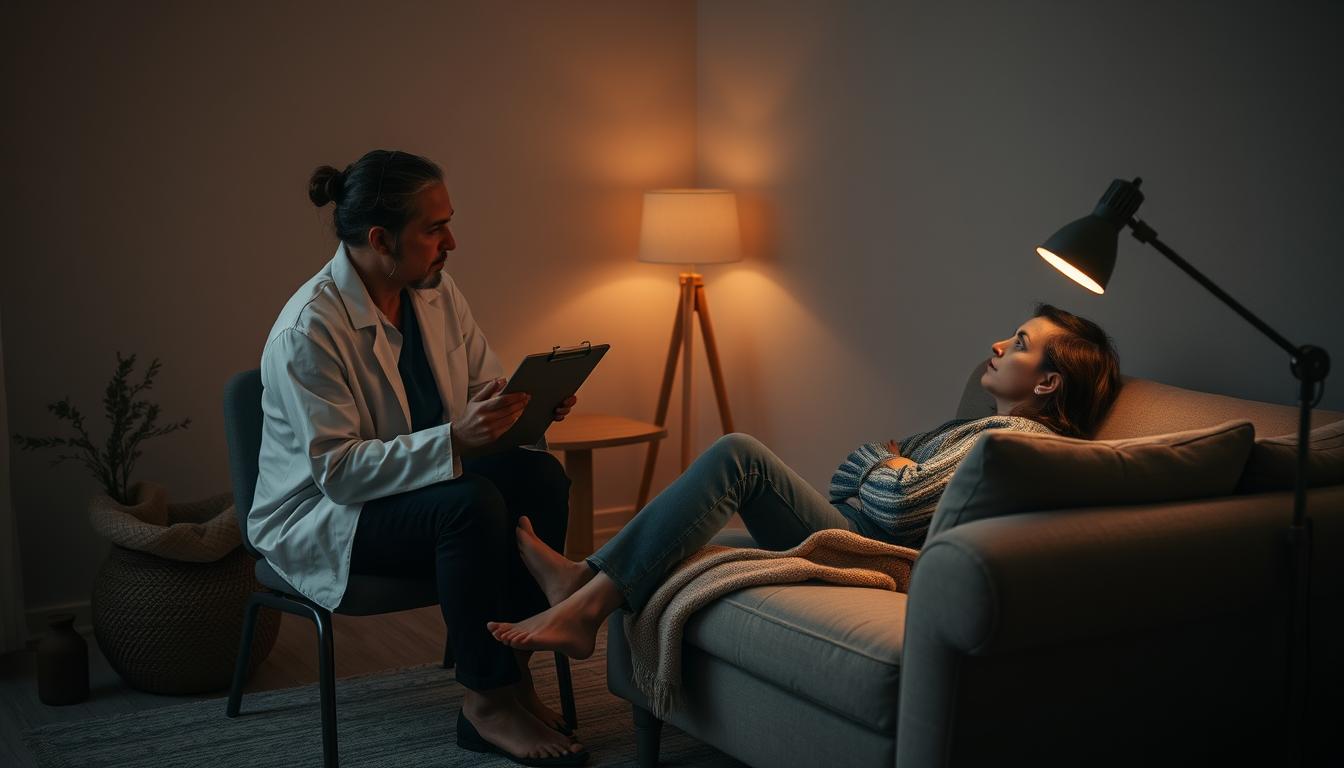I am a participant in the Amazon Services LLC Associates Program, an affiliate advertising program designed to provide a means for sites to earn advertising fees by advertising and linking to Amazon.com and affiliated sites. This post contains affiliate links. Privacy Policy
What Happens in a Therapy Session: Your Guide
Starting a therapy session for the first time can feel both exciting and scary. You’re ready to start a journey of self-discovery and healing. But, you’re not sure what to expect.

A psychological treatment session is a safe place to talk about your thoughts, feelings, and actions. It’s a team effort to understand and tackle your challenges.
Best brain supplement!
Key Takeaways
- You’ll have the chance to share your worries and goals with a therapist.
- In a typical therapy session, you’ll explore your thoughts, feelings, and actions.
- The therapist will help you find ways to handle your challenges.
- A therapy session overview will explain the process and what you can expect.
- The main goal is to give you tools for lasting change.
Preparing for Your First Therapy Session
Before your first therapy session, there are steps to take for a better experience. Preparing well can make you feel more at ease. It also helps you get the most from your time with your therapist.
Finding the Right Therapist for Your Needs
Finding the right therapist is key. Look at their specialization, therapeutic approach, and personality. Ask your healthcare provider, friends, or family for recommendations. Also, check online reviews and verify their credentials.
Paperwork and Initial Assessment
When you arrive, you’ll fill out paperwork. This includes consent forms and questionnaires about your mental health. This initial assessment helps your therapist understand your needs. Be detailed to ensure they grasp your situation fully.
Setting Your Expectations
It’s important to have realistic expectations about therapy. Remember, therapy is a collaborative process between you and your therapist. Here are some key points to consider:
- The first session is about getting to know your therapist and understanding the therapy process.
- Therapy is a journey, and progress may vary from person to person.
- It’s okay to feel nervous; it’s a sign that you’re taking a significant step towards your well-being.
By understanding these aspects, you can better prepare for a productive and meaningful therapy experience.
What Happens in a Therapy Session: The Step-by-Step Process
When you go to a therapy session, you’ll follow a structured plan. This plan is made to meet your specific needs and concerns. You and your therapist will work together to reach your goals.
The Welcome and Initial Check-in
The session starts with a warm welcome and a check-in. Your therapist will greet you and ask how you’re feeling. This initial check-in sets the session’s tone.
It’s your chance to share any immediate concerns or feelings. Your therapist might also review any paperwork or notes from before.
Discussion and Exploration Phase
The main part of the session is the discussion and exploration phase. Here, you’ll talk about the issues or topics you want to address. Your therapist will use therapeutic techniques to help you understand your thoughts, feelings, and actions.
- Identifying and challenging negative thought patterns
- Exploring past experiences and their impact on current behaviors
- Learning relaxation techniques or coping strategies
This phase is interactive and tailored to you. It ensures you’re actively involved in the therapy.
Closing and Between-Session Assignments
As the session ends, your therapist will summarize the main points. They’ll also give you between-session assignments. These tasks help you apply what you’ve learned and keep making progress.
The closing phase is also for feedback. You can share your thoughts on the session and any concerns. Your therapist will ensure you feel supported and understood.
Knowing the therapy session structure helps you engage more with the process. This way, you can get the most out of your therapy sessions.
Common Therapeutic Techniques You Might Experience
Learning about different therapy techniques can make you feel more at ease. Therapists use many methods to meet your unique needs and goals.
Cognitive Behavioral Therapy (CBT) Methods
Cognitive Behavioral Therapy (CBT) helps change negative thoughts and behaviors. CBT methods include:
- Keeping a thought journal to track patterns
- Challenging and reframing negative thoughts
- Engaging in activities you may have been avoiding
Psychodynamic and Talk Therapy Approaches
Psychodynamic therapy looks at how past experiences shape your thoughts and actions. This involves:
- Examining your emotional responses to different situations
- Discussing your relationships and interactions with others
- Understanding the unconscious motivations behind your actions
Through talk therapy, you can understand your feelings and behaviors better. This promotes personal growth and healing.
Mindfulness and Somatic Techniques
Mindfulness and somatic techniques focus on the mind-body connection. These practices include:
- Meditation and deep breathing exercises
- Body scans to release tension
- Mindful movement, such as yoga or tai chi
These techniques help you become more aware of your body and reduce stress.
Role-Playing and Behavioral Exercises
Role-playing and behavioral exercises are interactive. They help you practice new skills and behaviors. Examples include:
- Acting out different social scenarios
- Engaging in exposure therapy to overcome fears
- Practicing assertiveness and communication skills
These exercises can boost your confidence and help you develop better coping strategies.
Navigating Emotions During Your Therapy Sessions
In therapy, you might feel many emotions. It’s key to learn how to handle them. This is part of getting better.
Managing Difficult Feelings That Arise
You might feel anxious, sad, or frustrated in therapy. It’s important to recognize and accept these feelings. Your therapist can teach you ways to deal with them.
Mindfulness techniques can also help. They help you stay in the moment and understand your feelings better. This makes therapy more effective and improves your emotional health.
Building Trust with Your Therapist
Trust is vital for a good therapy experience. When you feel safe, you can share more. Trust grows with regular, caring interactions.
To build trust, be open and honest. Share your feelings and worries. This helps your therapist understand and support you better.
Confidentiality and Creating a Safe Space
Keeping your talks private is key in therapy. This privacy makes a safe space for you to share without fear.
A supportive therapist makes you feel more at ease. Their kind and understanding attitude helps you open up more.
Knowing about confidentiality and a safe space helps you deal with your feelings in therapy. This makes your sessions more effective and healing.
Tracking Your Progress and Therapeutic Outcomes
Your therapy journey is a team effort. You set goals, track progress, and make changes as needed. It’s key to know how to watch your progress and results.
Setting Meaningful Therapeutic Goals
Setting therapeutic goals is the first step to success in therapy. Goals should be specific, measurable, achievable, relevant, and have a deadline (SMART). This way, you can focus and track your progress better. Your therapist will help you set goals that match your needs and dreams.
For example, if you’re fighting anxiety, a goal might be to cut down on anxiety attacks by using relaxation techniques every day. Setting goals helps you stay on track and motivated.
Recognizing Signs of Improvement
Seeing signs of improvement is crucial to know if therapy is working. These signs can be better mood, stronger coping skills, or better relationships. You might find you’re more resilient to stress or better at dealing with tough situations.
“The goal of therapy is to help you develop the tools and strategies needed to manage your challenges and improve your quality of life.”
Talking about your progress with your therapist helps spot areas to improve and those that need more work.
Determining When to End or Adjust Therapy
Deciding when to stop or change therapy is a personal choice. It depends on how well you’re doing and what you need. You and your therapist will check your progress often. If you’ve reached your goals and feel ready to face life’s challenges, it might be time to end therapy or see your therapist less often.
If your current therapy isn’t working, you might need to try something new. This could mean trying different techniques or seeing a different therapist.
Conclusion: Maximizing the Benefits of Your Therapy Journey
Starting your therapy journey is exciting. It’s important to know how counseling works and what it can do for you. By being active in your sessions and setting goals, you can get the most out of therapy. This helps you feel better mentally.
A good relationship with your therapist is key. Trust and a safe space help you open up and tackle challenges. The structure of counseling sessions guides you through this, helping you see your progress.
For the best results, be open-minded and serious about your mental health. This way, you can fully benefit from therapy and see lasting changes. Your active role in therapy is what makes it effective.
FAQ
What is the typical structure of a therapy session?
A typical therapy session starts with a check-in. Then, you discuss and explore your feelings. It ends with a closing and sometimes homework for the next session.
How do I prepare for my first therapy session?
To get ready for your first session, find a therapist who fits your needs. Fill out any paperwork and know what to expect. Setting realistic goals can also help you feel less anxious.
What are some common therapeutic techniques used in therapy sessions?
Therapists use many techniques, like Cognitive Behavioral Therapy (CBT). They also use psychodynamic and talk therapy, mindfulness, and role-playing. They pick the best ones for you based on your goals.
How do I manage difficult feelings that arise during therapy sessions?
Handling tough feelings in therapy means building trust with your therapist. Remember, your talks are private, making a safe space. Be open to talking about your feelings.
How do I track my progress in therapy?
To track your progress, set clear goals for therapy. Look for signs of getting better and know when to stop or change therapy. Talking about your progress with your therapist is also helpful.
What is the role of between-session assignments in therapy?
Between-session tasks help you use what you learn in therapy every day. They help you keep growing and improving.
How do I know when it’s time to end therapy?
Deciding when to stop therapy means checking your progress and talking to your therapist. If you’ve reached your goals, you might be ready to end therapy.
What is the importance of confidentiality in therapy?
Confidentiality is key in therapy. It makes a safe space for you to share your feelings without fear of judgment or trouble.
How can I maximize the benefits of my therapy journey?
To get the most from therapy, be active in sessions and set meaningful goals. Keep a good relationship with your therapist. Being open and committed to your mental health helps too.
I am a participant in the Amazon Services LLC Associates Program, an affiliate advertising program designed to provide a means for sites to earn advertising fees by advertising and linking to Amazon.com and affiliated sites. This post contains affiliate links. Privacy Policy


